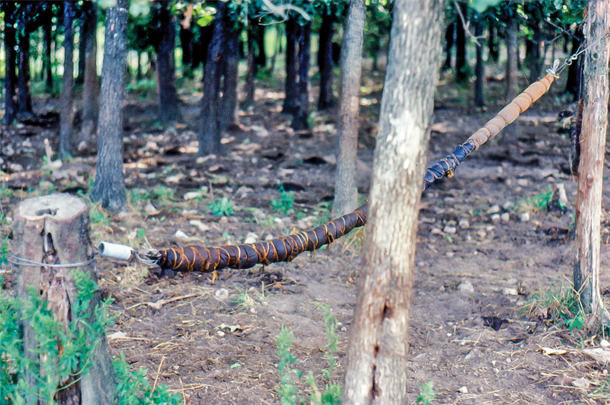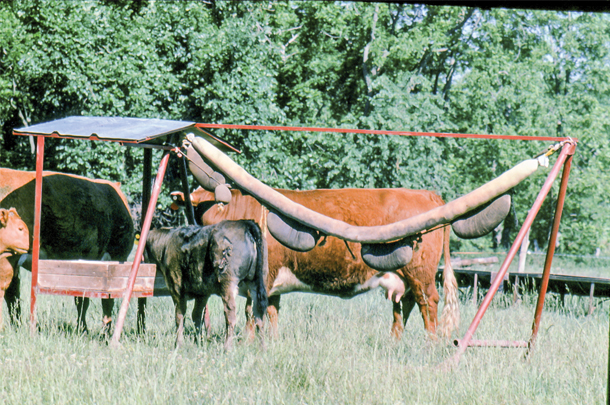Cattle producers understand the dollar impact these parasites have on animal performance and do their best to minimize the damage they can do to their overall profitability. Gains on steers have shown 20 to 30 pounds less when no fly control was used during a grazing season.
Parasite control comes in a variety of packages. I asked several producers during a meeting a few years ago what they used for fly control, and one reply was pretty simple: “tails.” Up to a point, the cow’s tail may be sufficient for some flies – until the threshold level for horn flies is reached.
The usual number recommended as a target for an economic response for horn flies is 200 flies per animal.
Tails serve no benefit when lice and ticks are on cattle. For control of those pests and larger numbers of flies, producers should resort to other practices, which may vary depending on the situation.
Without question, producers like convenient, low-labor methods for parasite control. For years, the monthly routine of spraying was viewed as the only real choice for controlling most pests.
Spraying with various products still works, but the labor and lack of convenient facilities makes it an unattractive option to many.
Back rubbers
In the 1950s, the beef industry started to promote the use of back rubbers treated with an insecticide mixed with diesel fuel or mineral oil. The rubbers had the mixture applied to them as needed. This was an innovation at the time and a welcome alternative to spraying.
The secret to success with the back rubbers is to find a location where the cattle visit almost daily. This might be a watering hole, salt or mineral feeding spot, a shady loafing area or a gateway they travel through as they change pastures.

Most of the original back rubbers were homemade from burlap sacks, wire and chains. Today, cattle producers can buy rubs ready to install and have the insecticide mix applied. There are no restrictions as to what the back rubber is made from or its size.
The pictures show the variations in design. For improved face fly control, producers may need to improvise with some strips hanging from the main rub.
I’ve always considered the basic back rubbers to be the most economical method for horn flies and lice control. They should be located where they can be used regularly during the insect season. In the spring, when fly numbers are way below the 200-per-animal level, producers may take the rubber down for a time. This may help on fly resistance to the insecticide. Rotating insecticides is highly recommended.
It is important that producers do not let cattle use a rub dripping with the oil-insecticide mix. Also, do not locate the rub where the drippage could enter the water supply. Some cattle may require a little coaxing to get them to go under the rubs if placed across a gateway.
This could pose a potential problem in hot weather if the gate leads to the only water supply.
There are also commercial cable-type back rubs with a reservoir in which the insecticide is placed. They are priced higher but do perform nicely if located near a loafing area.
Another back rubber innovation I’ve seen and heard about includes the use of insecticide-treated fly tags placed along a rope wire or cable instead of using a fabric-type rub with insecticide on it.
Dust bags
Dust bags are another self-treating option for fly and lice control. Once again, the trick is to place them where cattle are forced to go under them daily. They may give slightly better face fly control than back rubbers, but they need to be kept dry and observed frequently to see if the cattle are using them.

Operations moving toward management-intensive grazing find that dust bags and back rubbers fit right into their pasture management routine. These producers see and move their cattle regularly and find that it’s easy to move them under the device as they enter or exit the pasture.
In many pasture settings, however, the cattle often use a lane that leads to the water or mineral source, which provides a logical place to locate the rub or bag.
Fly tags and oral larvicides
Insecticide-treated fly tags work nicely if not applied too early in the spring and the insecticide is rotated from year to year. Fly resistance has led to some decline in the use of this method of parasite control.
In recent years, there has been increased use of oral larvicides, usually fed in mineral or feed supplements for fly control. The mode of action is to destroy the fly larvae in the manure.
This method reduces the fly population but does not repel the neighbor’s flies. The orals would not help in lice or tick control. Pour-on insecticides work but require running cattle through the chute.
Fly traps
An alternative horn fly control that some all-natural or organic beef cattle raisers have looked at is a fly trap. The trap was first used in the 1930s when insecticides were not as prevalent as they are today.
To view the trap design and corresponding plans, producers can visit the University of Missouri website’s Ag Guide Sheet (trap to control Horn Flies on cattle).
The trap does have some limitations, however, as it is only effective on horn flies. It can reduce the fly counts but never eliminates more than 50 to 60 percent of the flies. Some users of the trap caution that “boss” cows or bulls may like the shady trap so much they do not let other cattle walk through it.
When all is said and done, there is no fly, lice and tick treatment that is perfect for everyone or every pasture. I’m sure there will be new innovations developed, with the most recent one being the insecticide-containing paintball gun.
Researchers are also looking at cattle that attract fewer parasites so someday we may have an expected progeny difference that may be used to select breeding stock that may not need fly tags, pour-ons, sprays, etc. In the meantime, realize those pests can reduce animal performance and transmit disease. Controlling them is financially worthwhile. ![]()
Eldon Cole is a livestock specialist at the University of Missouri. Email Eldon Cole.
PHOTO 1: A traditional back rubber with flaps for face fly protection. Cattle must use it as they go to the waterer.
PHOTO 2: A homemade back rubber located in the shady area where cattle loaf.
PHOTO 3: A portable back rubber and mineral feeder designed to move from pasture to pasture. Photos provided by Eldon Cole.






